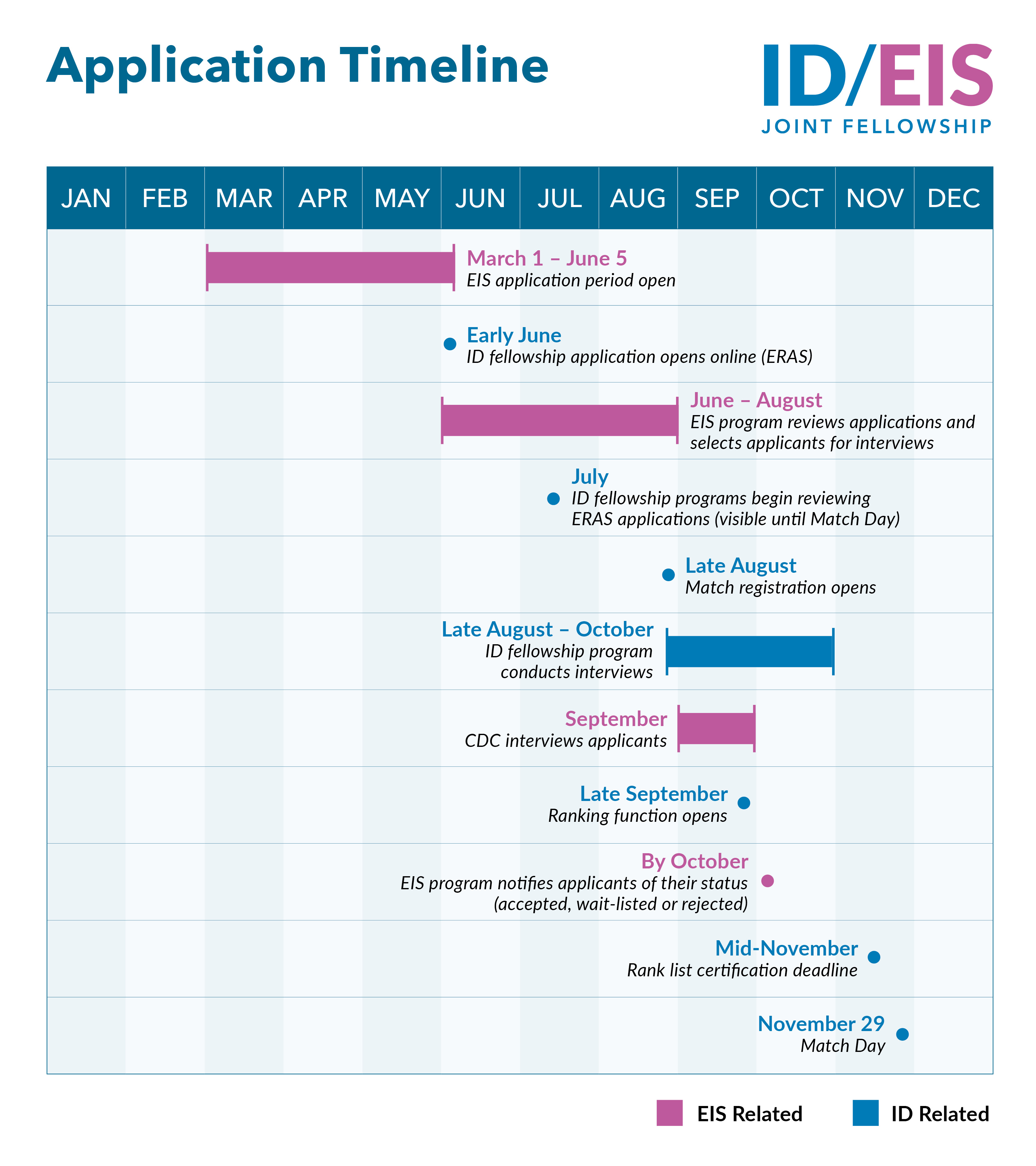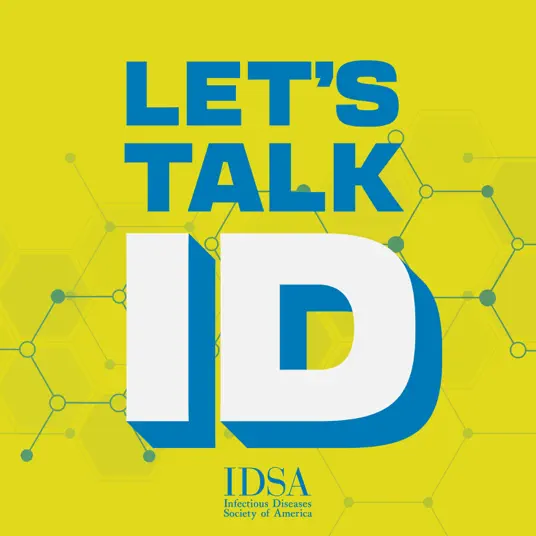The ID/EIS joint fellowship program streamlines a career path for applicants interested in both the ID fellowship and EIS program. The joint ID/EIS fellowship uses the existing EIS and ID fellowship applications, and applicants must apply separately to both the EIS and the ID fellowship programs.
The joint fellowship provides a pathway to leadership roles with CDC, state and local health departments, the Indian Health Service, hospital epidemiology, pharmaceutical companies, academia and in media.
Select from the categories below to learn more about joint fellowship eligibility, the application process, and upcoming informational sessions.
Applicants must submit the EIS application before the EIS deadline and the ID fellowship application separately in ERAS before moving on to the Match process in NRMP. The EIS application for 2023 closed on June 5, 2023. Applicants to the joint fellowship in EIS must also apply to a joint fellowship track in ERAS at a participating ID fellowship institution to complete their joint fellowship application.
If you plan to apply in the future, visit the CDC EIS site to learn more about their application process and requirements. Review the participating ID fellowship websites for their application process and requirements. Additionally, you can view past Q&A webinars, from Sept. 26, 2022 and Dec. 5, 2022 and visit the EIS website for planned EIS-specific webinars.
Applications are not currently being accepted to the joint program but may be in the future.
Eleven ID fellowship programs, listed below, were selected for the first year of the ID/EIS pilot with the first round of candidates applying in early 2023. Learn about the ID fellowship programs, including specific opportunities, eligibility requirements, salary information and more, at the links below.
Applicants interested in the ID/EIS fellowship must meet both ID fellowship and EIS eligibility criteria.
The joint ID/EIS fellowship program uses a parallel application process. The joint fellowship will follow existing application timelines for ID and EIS fellowships (EIS timeline).
Applicants must apply separately to both the EIS and the ID fellowship programs in the same application cycle and be accepted by both programs to be part of the joint ID/EIS fellowship program.
The EIS and ID fellowship programs independently review applications and select candidates using their separate interview and decision-making processes. Only applicants who meet standards for both programs will be accepted to the joint ID/EIS fellowship program. Acceptance to one program does not guarantee acceptance to another program or to the joint ID/EIS fellowship program. Acceptance to the EIS program does not guarantee acceptance to an ID fellowship or the joint fellowship program.
Applicants will find out their EIS application status before completing the ranking process in NRMP for the ID Fellowship Match. Applicants can rank either the joint fellowship or traditional ID fellowship track in NRMP depending on their preference.
Joint fellows will begin their ID fellowship program in July of the year following their application. Joint fellows will attend the EIS conference in April/May of their first year of ID fellowship. At the EIS conference, they will go through the EIS match process to determine their EIS placement. Regional field EIS placements near the ID fellowship and Atlanta-based placements are available.
The application process occurs in parallel. Applicants must complete both the EIS application, using the EIS platform, and the ID fellowship application in ERAS. Both applications must be completed in the same cycle. For example, candidates would apply to EIS and the ID fellowship in 2023 to be considered for the joint fellowship starting in 2024.
Information on how to prepare your EIS application is available on CDC’s website. Each ID fellowship has slightly different requirements for materials to complete an application. Check the program(s) websites for specific application requirements.
The joint ID/EIS fellowship uses the existing EIS and ID fellowship program application timelines. Generally, the EIS application precedes the ID fellowship program application, so applicants will need to manage the two timelines.
For planning purposes, the EIS fellowship application deadlines and dates for the Class of 2023 are listed on their website. Below is a timeline of the application process for both ID and EIS fellowship programs for 2023.

Applications for the first cohort of fellows opened in early spring 2023 for placement in two-year ID programs in July 2024. This first cohort will then join the EIS Class of 2026. During the pilot stage, schedules outside of the timeline cannot be accommodated (e.g., starting an ID fellowship in September instead of July).
Joint ID/EIS fellows will be hired and paid according to the ID fellowship institution’s procedures for the first two years of the program (which may include a T32 grant for F2) and then by CDC during the EIS portion of the program. During the EIS portion of the program, joint fellows will be hired and paid by CDC, as described on its website.
Each ID fellowship program offers different salary and benefits packages. Check the website of participating ID fellowship programs to learn about the salary and benefits offered.
The joint fellowship is designed for candidates to complete a two-year ID fellowship and immediately proceed to the EIS program, completing both within 4 years. However, circumstances may change in terms of a fellow's availability to complete the programs in the planned timeline.
If a fellow needs to take extended leave (e.g., parental or other FMLA leave), these situations will be handled on a case-by-case basis with the CDC and ID fellowship program. If a fellow takes extended leave during the ID program, they have additional time to complete their program (per ACGME compliance requirements). However, this adjustment may impact their start date for the EIS program, which can only begin in July. Extended leave requests during the EIS fellowship will be handled by CDC on a case-by-case basis.
Should an accepted fellow decide not to complete the joint fellowship, they will need to notify both their ID fellowship and CDC about their decision. If an individual chooses to not complete the ID fellowship, they will need to re-apply to the EIS program if they want to complete that program. These situations will be handled on a case-by-case basis with CDC and the ID fellowship program.
Please check back for information on future webinars. View past Q&A webinars, from Sept. 26, 2022 and Dec. 5, 2022.
Check the EIS website for planned EIS-specific webinars.

Joint fellowship leaders discuss the ID/EIS program and benefits in a recent episode of Let’s Talk ID. IDSA President Carlos del Rio, MD, FIDSA, hosts Molly Paras, MD, FIDSA, program director of the Massachusetts General Hospital/Brigham and Women’s Hospital Infectious Diseases Fellowship, and Eric Pevzner, PhD, MPH, chief of the Epidemiology and Laboratory Workforce Branch in the Division of Workforce Development at CDC, to discuss the joint fellowship opportunity and the value it will bring to public health.
To sign up for updates on the Joint ID/EIS Fellowship Program, submit email here. Please indicate if you are a potential applicant or with an ID Fellowship program.
The joint ID/EIS fellowship pilot program is funded by a cooperative agreement with the Centers for Disease Control and Prevention (grant number NU50CK000574). The Centers for Disease Control and Prevention is an agency within the Department of Health and Human Services (HHS). The information on this page does not necessarily represent the policy of CDC or HHS, and should not be considered an endorsement by the Federal Government.